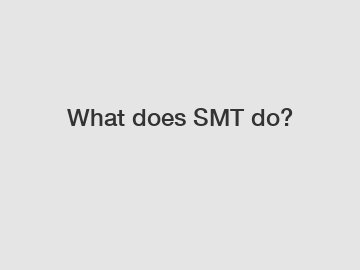What does SMT do?
What does SMT do?
SMT, which stands for Surface Mount Technology, is a key process used in the manufacturing of electronic circuits. It plays a crucial role in placing and soldering electronic components onto printed circuit boards (PCBs). Through this process, electronic devices such as smartphones, computers, and televisions are built.
The origins of SMT can be traced back to the late 1960s when the demand for smaller, lighter, and more efficient electronic devices began to rise. Traditional methods of component insertion and soldering, such as through-hole technology, were no longer suitable for meeting these requirements. SMT emerged as a highly efficient alternative that enables manufacturers to maximize space utilization on PCBs and increase production speed.

To understand the process of SMT, it is essential to recognize its key components and steps. The main components of SMT are the electronic components, the PCB, and the assembly equipment. Electronic components, such as resistors, capacitors, integrated circuits, and connectors, are mounted onto the PCB using automated assembly machines.
The process begins with the application of solder paste onto the PCB pads. This paste contains a mixture of metal particles and flux, which helps to create a bond between the components and the PCB. Once the solder paste is applied, the components are placed onto their respective positions using pick-and-place machines. These machines accurately position the components onto the PCB, ensuring their proper alignment and orientation.
After component placement, the PCB is subjected to a reflow oven, where the solder paste is heated, causing it to melt and form a secure bond between the components and the PCB. This melting process, known as reflow soldering, ensures a reliable electrical connection. Once the solder is cooled, the components are permanently attached to the PCB.
The adoption of SMT has had a significant impact on the electronics industry. Firstly, it has revolutionized the design and manufacturing process of electronic devices. With SMT, manufacturers are able to produce smaller, slimmer, and more efficient devices that meet the demands of the modern consumer. The reduction in size also allows for higher component density, leading to improved functionality.
Secondly, SMT has increased production efficiency and reduced manufacturing costs. The automated nature of the SMT process allows for high-speed assembly, significantly reducing production time compared to traditional methods. Additionally, the accuracy of component placement achieved by SMT machines minimizes the risk of errors and rework, further improving efficiency.
Lastly, SMT enables the use of advanced technology and components. As electronic devices become more complex, the miniaturization of components is necessary. SMT facilitates the use of smaller and more advanced components, such as microprocessors and microcontrollers, which are crucial for the development of cutting-edge technologies like artificial intelligence, Internet of Things, and autonomous vehicles.
In conclusion, SMT revolutionizes the manufacturing of electronic circuits by providing a highly efficient and accurate method of component placement and soldering. Its origins in meeting the demands for smaller and more efficient electronic devices have resulted in improved design, increased production efficiency, and the ability to incorporate advanced technology. SMT is undoubtedly the backbone of modern electronics manufacturing, shaping the way we live and interact with technology.
Are you interested in learning more about Dual Lane Conveyors, smart gate conveyor, PCB Flipper? Contact us today to secure an expert consultation!


